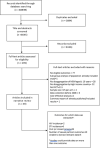Effectiveness of interventions aimed at reducing HIV acquisition and transmission among gay and bisexual men who have sex with men (GBMSM) in high income settings: A systematic review
- PMID: 36260550
- PMCID: PMC9581368
- DOI: 10.1371/journal.pone.0276209
Effectiveness of interventions aimed at reducing HIV acquisition and transmission among gay and bisexual men who have sex with men (GBMSM) in high income settings: A systematic review
Abstract
Introduction: HIV transmission continues among gay and bisexual men who have sex with men (GBMSM), with those who are younger, or recent migrants, or of minority ethnicity or who are gender diverse remaining at increased risk. We aimed to identify and describe recent studies evaluating the effectiveness of HIV prevention interventions for GBMSM in high income countries.
Methods: We searched ten electronic databases for randomized controlled trials (RCTs), conducted in high income settings, and published since 2013 to update a previous systematic review (Stromdahl et al, 2015). We predefined four outcome measures of interest: 1) HIV incidence 2) STI incidence 3) condomless anal intercourse (CLAI) (or measure of CLAI) and 4) number of sexual partners. We used the National Institute for Health and Care Excellence (UK) Quality Appraisal of Intervention Studies tool to assess the quality of papers included in the review. As the trials contained a range of effect measures (e.g. odds ratio, risk difference) comparing the arms in the RCTs, we converted them into standardized effect sizes (SES) with 95% confidence intervals (CI).
Results: We identified 39 original papers reporting 37 studies. Five intervention types were identified: one-to-one counselling (15 papers), group interventions (7 papers), online interventions (9 papers), Contingency Management for substance use (2 papers) and Pre-exposure Prophylaxis (PrEP) (6 papers). The quality of the studies was mixed with over a third of studies rated as high quality and 11% rated as poor quality. There was some evidence that one-to-one counselling, group interventions (4-10 participants per group) and online (individual) interventions could be effective for reducing HIV transmission risk behaviours such as condomless anal intercourse. PrEP was the only intervention that was consistently effective at reducing HIV incidence.
Conclusions: Our systematic review of the recent evidence that we were able to analyse indicates that PrEP is the most effective intervention for reducing HIV acquisition among GBMSM. Targeted and culturally tailored behavioural interventions for sub-populations of GBMSM vulnerable to HIV infection and other STIs should also be considered, particularly for GBMSM who cannot access or decline to use PrEP.
Conflict of interest statement
The authors have declared that no competing interests exist.
Figures





References
-
- UNAIDS. Global HIV & AIDS statistics—Fact sheet [Available at www.unaids.org2021]
-
- Centers for Disease Control. HIV and Gay and Bisexual Men: Centers for Disease Control, USA; 2018. [Available from: https://www.cdc.gov/hiv/pdf/group/msm/cdc-hiv-msm.pdf.
-
- European Centre for Disease Prevention and Control. HIV/AIDS surveillance in Europe 2021–2020 data. Stockholm: ECDC, 2021.
-
- The Kirby Institute. HIV, viral hepatitis and sexually transmissible infections in Australia:annual surveillance report 2018. Sydney: Kirby Institute, UNSW; [Available from https://kirby.unsw.edu.au/report/asr2018].
-
- Centers for Disease Control Control. Estimated HIV Incidence and Prevalence in the United States, 2015–2019. 2021.
Publication types
MeSH terms
Grants and funding
LinkOut - more resources
Full Text Sources
Medical
Research Materials
Miscellaneous

